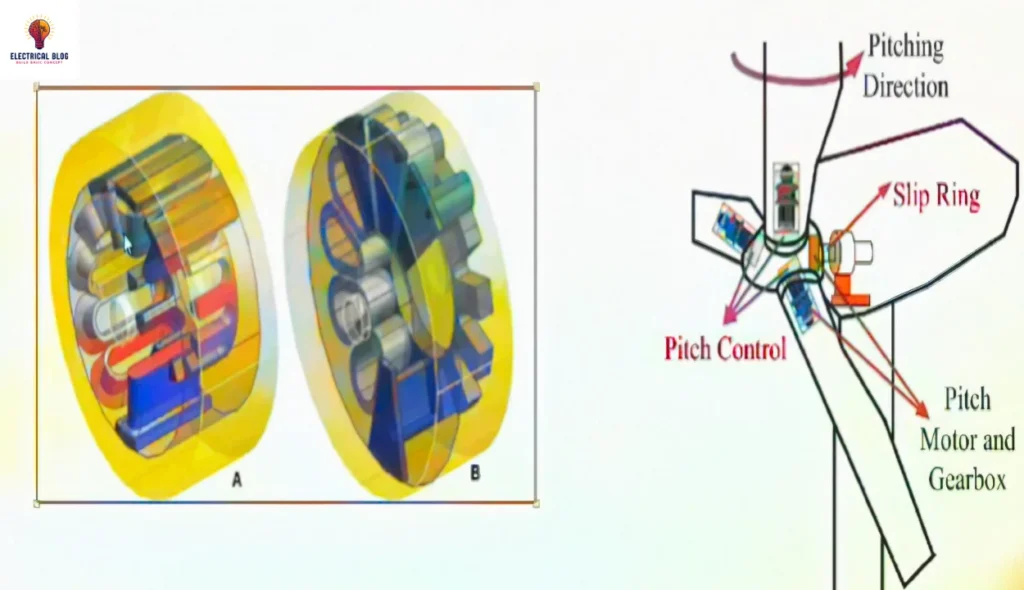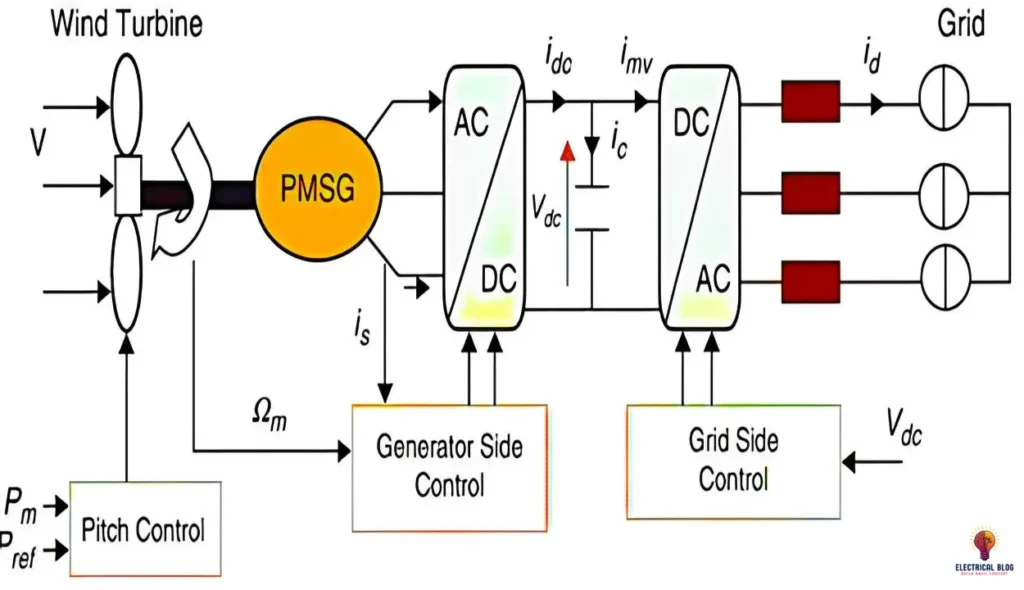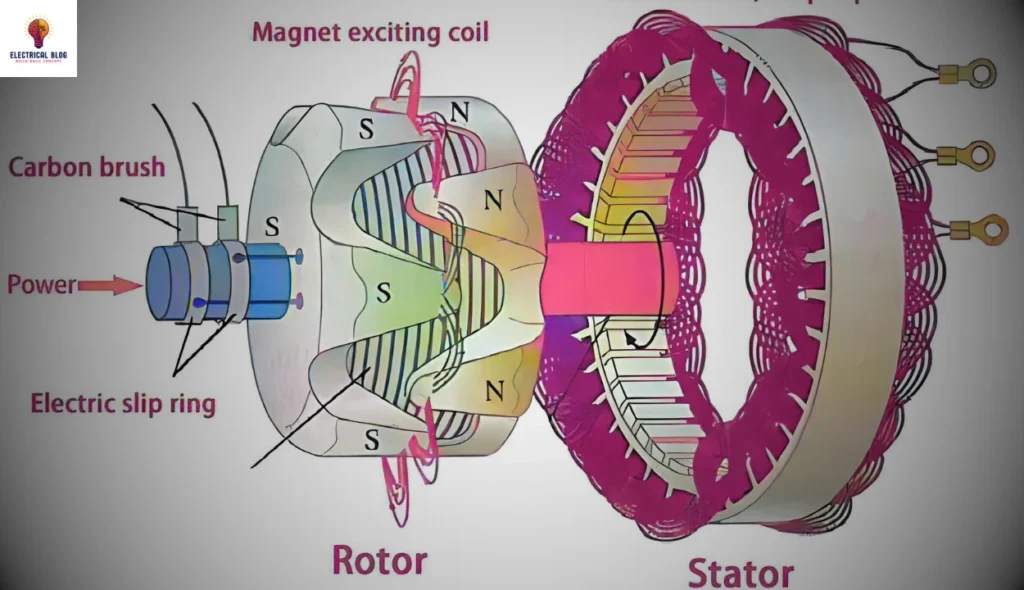Introduction
A Permanent Magnet Synchronous Generator (PMSG) is a type of generator. It is now very important in modern electrical systems. It uses permanent magnets, not electromagnets. It converts mechanical energy into electrical energy. This design is more efficient and reliable. So, it is key in many renewable energy applications.
Permanent Magnet Synchronous Generator is mainly used in wind turbines. It efficiently converts wind energy into electricity. The wind turns the turbine’s blades. The PMSG generates electricity with minimal energy loss. Additionally, some hydropower plants use PMSGs. They harness water flow to drive the generator, generating renewable energy.
This article will explore the tech and benefits of Permanent Magnet Synchronous Generator in energy systems, like wind and hydropower. It will highlight its role in promoting sustainable and efficient energy solutions.
What is a Permanent Magnet Synchronous Generator?
In my experience working with power systems, I’ve found that a Permanent Magnet Synchronous Generator stands out for its efficient design. Instead of relying on a coil for excitation, it uses a permanent magnet to create the magnetic field. This design ensures the rotor and field move at the same speed, keeping the system synchronous. The mechanism involves a shaft-mounted setup, which allows the magnetic force to efficiently transfer current to the stationary armature through an induced process. This streamlined design makes these generators highly reliable for various applications.
Working Principle of Permanent Magnet Synchronous Generator
PMSG starts with Faraday’s Law of electromagnetic induction. When the rotor rotates, its embedded permanent magnets create a magnetic field in motion, which induces an EMF in the stator windings. The output frequency and electricity produced depend directly on the rotational speed of the rotor, ensuring efficient power-generating performance.
The steady magnetic field from the magnets eliminates the need for an external power source to excite the generator. The stator features three-phase windings that deliver the output voltage. Unlike traditional synchronous generators, this rotor has no windings, brushes, or slip rings. This design cuts down on maintenance and improves system reliability.
Permanent Magnet Synchronous Generator diagram

Design and Construction of Permanent Magnet Synchronous Generators
From my experience working with synchronous generators, their design focuses on efficiency and stability. The rotor often includes a rotating magnet that helps create a stable magnetic field. The stationary armature, containing the armature winding, is carefully wound to ensure smooth induced currents. In standard utility equipment, the system maintains synchronicity with the grid, ensuring consistent electrical power output. The rotating assembly combines two fields, maintaining a fixed position relative to each other during rotation, which keeps the system stable and effective.
The stator magnetic field plays a key role by interacting with the rotor to generate torque and improve uniformity. In designs for wind turbines, hydro turbines, or steam turbines, this setup efficiently converts mechanical power into electrical energy. The diagram of these systems often shows the parallel component of the stator field controlling voltage, while the perpendicular component affects torque. Systems supplying an inductive or capacitive load may show angles greater than 90°, leading to an increased or opposite effect on the generator’s voltage. This design ensures stable performance across commercial and utility applications.
Applications of Permanent Magnet Synchronous Generators
Permanent magnet synchronous generators are widely used in wind turbines due to their efficient design. These PMGs offer stable output voltage that is proportional to speed, making them ideal for variable wind conditions. With no excitation circuit, slip rings, or contact brushes, they require less maintenance and reduce structural issues during operation.
In industrial settings, permanent magnet alternators are favored for their high-performance capabilities. However, challenges like core saturation, thermal issues, and persistent magnetic field risks during assembly and repair must be managed. These generators often require external control systems or control circuits to ensure stable voltage regulation and prevent unstable air-gap flux density effects.
Pilot generators are used in smaller applications. They measure speed and supply excitation current to larger machines on the same shaft. While excitation current control is sometimes necessary, in some cases, voltage regulation may not be required. Advanced solutions like power electronic devices are often mounted on the rotating system for seamless performance and are controlled externally.
Advantages of Permanent Magnet Synchronous Generators
Permanent magnet synchronous generators offer efficient performance since they do not need a DC supply for the excitation circuit. This design removes slip rings and contact brushes. This change cuts down on maintenance and boosts reliability in many applications.
These generators provide steady output voltage. They do this with a stable magnetic field, so they don’t need complex control systems. The absence of air gap flux adjustments simplifies operation, making them ideal for both small and large systems.
PMGs ensure enhanced efficiency with reduced core saturation risks and improved air-gap flux density control. This combination allows for high torque output while minimizing thermal issues and ensuring long-term stability.
Challenges and Limitations of Permanent Magnet
While PMSG offers numerous advantages, several challenges and limitations arise in practical applications. Below are some of the key issues that must be considered:
- A major challenge with PMSG is the high cost of materials, especially rare earth magnets. Materials like neodymium are vital for peak performance. But they are often expensive. Their scarcity and geopolitical issues cause price swings. This makes the overall system more costly.
- Good cooling and thermal management are vital for PMSG. They boost its lifespan and performance. Without good thermal solutions, heat can cause damage and failures. We must use efficient thermal management, like advanced heat exchangers. But it makes the design more complex.
- PMSG control systems can be complex. They require precise control of torque, speed, and voltage. It is tough to balance complex control systems with high efficiency in variable-speed applications, like wind turbines.
Future Trends in PMSG Technology
A major advance in PMSG technology is new magnet materials. Traditional PMSGs rely on rare earth metals like neodymium. They are expensive and in limited supply. To combat this, research aims to create new magnet materials. They should reduce or eliminate the need for rare earth elements. This would lower costs and reduce supply chain risks. They are exploring recycling and new alloys to reduce this dependency and improve sustainability.
Another key trend is the integration of energy storage systems with PMSG technology. By using PMSG with advanced batteries, we can store excess energy. We can then release it during high-demand periods. It boosts efficiency, stabilizes the grid, and supports renewables like wind and hydro. The ability to store energy makes PMSG systems more adaptable to varying energy loads.
As smart grids spread, PMSG technology is evolving to work better with them. Smart grid compatibility lets PMSGs talk to other grid parts. This optimizes power distribution and management. Also, advanced control systems are being developed. They aim to improve the performance and efficiency of PMSGs in real time. This will ensure they meet the demands of modern energy infrastructures.
Conclusion
The push for sustainable energy has made Permanent Magnet Synchronous Generators vital in renewables. PMSGs are highly efficient and reliable. So, they are great for wind energy applications. They excel at converting mechanical energy into electrical energy. Recent research shows that PMSG wind turbines can greatly improve performance. They are especially good in varying winds. This maximizes energy output and boosts system efficiency.
As demand for cleaner energy rises, Permanent Magnet Synchronous Generator technology will likely grow. It will integrate with other renewable systems, like solar power. This integration can optimize energy use, especially via energy storage systems. They can store excess energy from peak production for use during high demand.
In conclusion, the rise of PMSGs marks a key shift. It is towards more efficient and sustainable energy solutions. PMSG technology will be key to renewable energy. This is due to better control systems and magnet materials. It will help create a cleaner, more resilient energy grid. The future of energy generation will likely be defined by such innovations. They will ensure renewable energy systems can meet rising energy demands sustainably.
Read more: Transformer Efficiency


